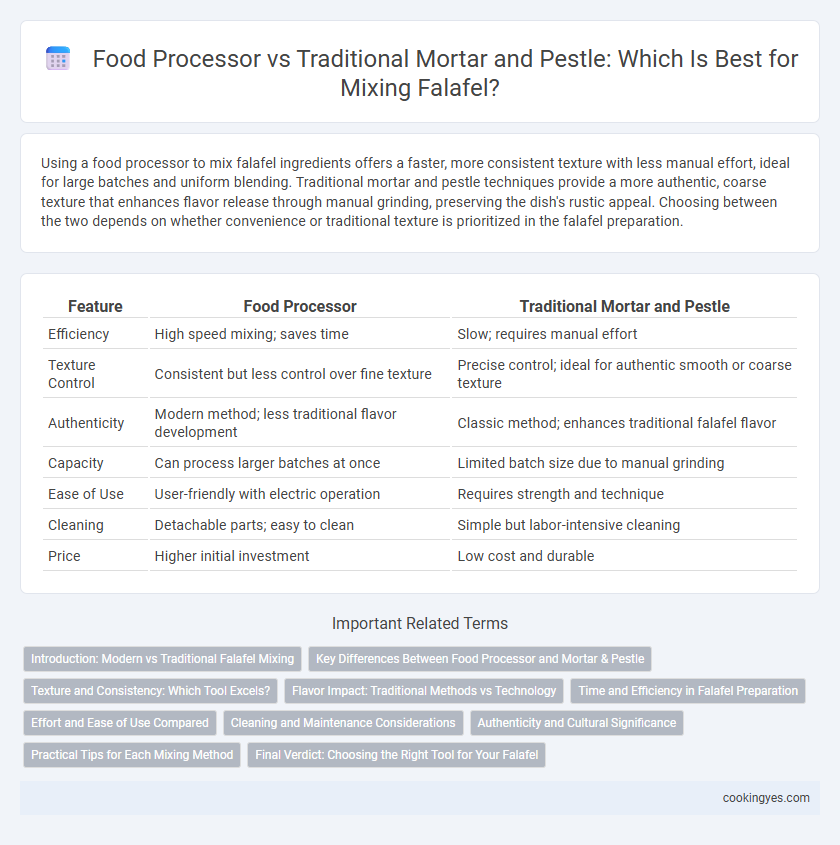Using a food processor to mix falafel ingredients offers a faster, more consistent texture with less manual effort, ideal for large batches and uniform blending. Traditional mortar and pestle techniques provide a more authentic, coarse texture that enhances flavor release through manual grinding, preserving the dish's rustic appeal. Choosing between the two depends on whether convenience or traditional texture is prioritized in the falafel preparation.
Table of Comparison
| Feature | Food Processor | Traditional Mortar and Pestle |
|---|---|---|
| Efficiency | High speed mixing; saves time | Slow; requires manual effort |
| Texture Control | Consistent but less control over fine texture | Precise control; ideal for authentic smooth or coarse texture |
| Authenticity | Modern method; less traditional flavor development | Classic method; enhances traditional falafel flavor |
| Capacity | Can process larger batches at once | Limited batch size due to manual grinding |
| Ease of Use | User-friendly with electric operation | Requires strength and technique |
| Cleaning | Detachable parts; easy to clean | Simple but labor-intensive cleaning |
| Price | Higher initial investment | Low cost and durable |
Introduction: Modern vs Traditional Falafel Mixing
Food processors provide a fast and consistent blend of falafel ingredients, preserving texture while saving time compared to the traditional mortar and pestle method. Mortar and pestle grinding releases essential oils and maintains a coarse texture, resulting in authentic falafel flavor and bite. Choosing between these methods depends on balancing convenience with the desire for traditional taste and texture.
Key Differences Between Food Processor and Mortar & Pestle
A food processor offers speed and efficiency by quickly blending falafel ingredients into a consistent mixture, ideal for large batches and uniform texture. In contrast, a traditional mortar and pestle provide greater control over texture and allow gradual blending, preserving the falafel's authentic, coarser consistency. While food processors use electrical power for convenience, mortar and pestle rely on manual effort, enhancing flavor release through slow grinding.
Texture and Consistency: Which Tool Excels?
A food processor creates a uniformly smooth and creamy falafel mixture by finely chopping ingredients quickly, ideal for consistent texture and easier shaping. Traditional mortar and pestle allow for greater control over the falafel's texture, preserving a coarser, chunkier consistency that enhances the rustic, authentic bite. Texture preferences vary, but processors excel in speed and uniformity, while mortar and pestle dominate in maintaining traditional, artisanal falafel characteristics.
Flavor Impact: Traditional Methods vs Technology
Using a traditional mortar and pestle for mixing falafel ingredients enhances flavor by gently bruising chickpeas and spices, releasing essential oils and aromas that modern food processors may pulverize too quickly, resulting in a less vibrant taste. Food processors offer speed and convenience but can overwork the mixture, causing heat that may diminish the natural freshness and texture critical to authentic falafel flavor. This balance between preserving the integrity of ingredients and achieving consistent mixing defines the flavor impact when comparing traditional methods with technology in falafel preparation.
Time and Efficiency in Falafel Preparation
Using a food processor for mixing falafel ingredients significantly reduces preparation time, enabling a consistent and finely ground mixture within minutes. Traditional mortar and pestle require more physical effort and time, often resulting in a coarser texture and less uniform blending. For efficient falafel preparation, the food processor enhances productivity while maintaining flavor and texture quality.
Effort and Ease of Use Compared
A food processor significantly reduces effort and time when mixing falafel ingredients, providing uniform texture with minimal manual labor. Traditional mortar and pestle require physical strength and patience but offer precise control over the mixture's consistency and authenticity in flavor extraction. For ease of use, a food processor is ideal for quick preparation, while the mortar and pestle suit those valuing traditional techniques despite increased effort.
Cleaning and Maintenance Considerations
Food processors offer quick cleaning with detachable, dishwasher-safe parts that reduce effort and time compared to traditional mortar and pestle, which require thorough hand washing to remove sticky falafel mixture residues. Mortar and pestle demand consistent maintenance to prevent stain buildup and preserve stone integrity, while food processors occasionally need deep cleaning to avoid food odor retention and blade dullness. Choosing between the two depends on convenience preferences, kitchen space, and commitment to regular appliance care.
Authenticity and Cultural Significance
Using a traditional mortar and pestle to mix falafel preserves the authentic texture and flavor, allowing the ingredients to release their natural oils and aromas in a way that replicates centuries-old Middle Eastern culinary practices. A food processor offers convenience and speed but often over-processes the mixture, leading to a denser consistency that can compromise the falafel's traditional light, crumbly texture. The mortar and pestle not only enhance the cultural significance of falafel preparation but also connect the cook with the heritage and artisanal techniques passed down through generations.
Practical Tips for Each Mixing Method
Using a food processor for falafel offers speed and consistent texture, ideal for busy kitchens and precise blending of chickpeas and spices. A traditional mortar and pestle provides greater control over ingredient coarseness and releases essential oils gently, enhancing flavor complexity. For best results, combine pulse-processing in a food processor with some manual mashing to balance efficiency and authentic texture.
Final Verdict: Choosing the Right Tool for Your Falafel
A food processor offers speed and uniformity when mixing falafel ingredients, ensuring a consistent texture that's ideal for quick preparation and larger batches. Traditional mortar and pestle techniques provide a more controlled, rustic blend that preserves the authentic, coarse texture crucial to classic falafel recipes. The best choice depends on your desired falafel texture and time constraints, with the food processor favored for efficiency and the mortar and pestle valued for traditional authenticity.
Food processor vs Traditional mortar and pestle for mixing Infographic

 cookingyes.com
cookingyes.com